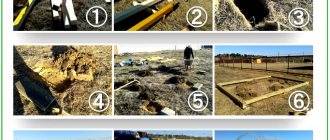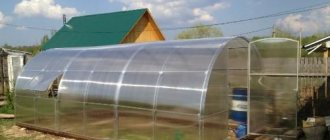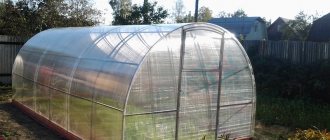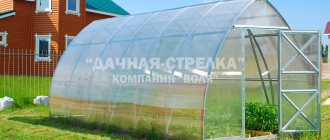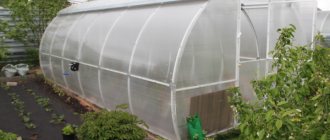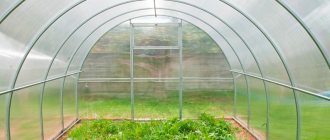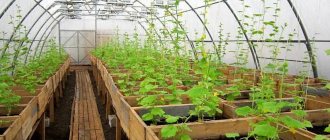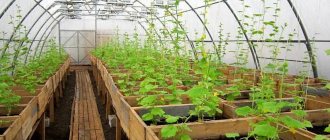Main design features
The basic model is the Kremlin Lux. This greenhouse has a height of 2.1 m. Its length can be different - from 4 meters to infinity. But it is always a multiple of two. The frame of the greenhouse is made of steel profile 20 x 20 mm. The step between intermediate trusses is 1 m. The cladding is made of cellular polycarbonate. The basic model has a classic arched shape.
What is the secret of the reliability of such a structure as the Kremlevskaya greenhouse? The truss in structures of this type is the most important element responsible for strength and durability. The stronger this structural part, the longer the greenhouse will last. The main feature of the Kremlevskaya greenhouse is the presence of double trusses. Thanks to this, the structure can withstand very heavy snow loads - up to 300 kg per m2. The double arches are connected by nine steel bridges. The trusses are prefabricated and consist of two halves. The distance between the arches in them is 10 cm. The pitch between the horizontal stiffeners is 610 mm. Thus, the size of one cell-opening in the Kremlevskaya greenhouse is 610 (height) x 990 (width). The structure is assembled using special fasteners - “crabs systems” or “spiders” - on bolts. The frame is painted using powder technology at high temperatures. Therefore, the coating of trusses and lintels does not need to be periodically updated.
Windows in the amount of 2 pcs. Each model has been retrofitted, including the basic “Kremlin Lux”. The greenhouse also has two doors at both ends. The latter consist of three halves. This design is designed specifically to facilitate transportation of the greenhouse to its destination. You can transport the disassembled frame on the trunk of a regular car. The Kremlevskie greenhouses do not weigh too much (one section – 30 kg).
Which polycarbonate greenhouse is better to buy?
A greenhouse is not a cheap purchase, so such a structure should last a long time. The main components of the greenhouse are a frame and a polycarbonate covering.
The frame must be strong, capable of withstanding not only hurricane winds, but also considerable snow loads.
And here it all comes down to the material of its manufacture:
- Plastic pipes are cheap, easy to assemble into a frame, and do not corrode. But the very first snowy winter will reduce all these advantages to nothing: the greenhouse will simply collapse under the weight of the snow, and the supports will not help. In addition, the rigidity of polycarbonate sheets exceeds that of plastic arches, so low strength is inherent in the design itself.
- The aluminum profile will not rust, and lightweight products are easy to transport. Alas, they do not have the necessary rigidity - they bend under the weight of snow and require careful strengthening in the foundation.
- Galvanized steel has sufficient strength and durability. If the cross-section of the frame element is rectangular or square with a metal thickness of at least 1.2 mm, then this option will be optimal. A frame made of galvanized pipes (preferably without welded elements) also serves well.
Of the two types of polycarbonate - monolithic and cellular, you should choose the latter for a greenhouse: it is lighter and holds heat better.
The thickness is also important - it should be at least 4 mm and no more than 10, otherwise the coating will transmit light poorly. On the other hand, it is directly related to thermal conductivity - the thicker the leaf, the warmer the plants will be.
Without an additional layer that protects polycarbonate from ultraviolet radiation, even the highest quality material will quickly deteriorate.
A special film is glued only on the outside, although many manufacturers limit themselves to using special coating.
The main thing to remember: only transparent, unpainted polycarbonate allows enough sunlight to pass through.
What else you need to pay attention to when choosing a greenhouse:
- The pitch of the arcs - the closer they are to each other, the more reliable the structure;
- Availability of seals in the kit;
- Additional options - doors and vents for ventilation;
Greenhouses can be industrial - with heating for year-round use - or seasonal. The shape of the roof is chosen depending on the needs, but on a steep, pointed roof, snow is retained less.
Recommendations: 10 Best Drip Irrigation Systems
12 best heat guns
15 best cultivators and walk-behind tractors
Model "Fairy Tale"
The “Kremlin” greenhouse of this variety also has a strong frame made of double trusses. Its difference from the base model is in its shape. The roof of the “Fairy Tale” structures is arched, and the walls are vertical. In addition, the greenhouses of this model have a slightly smaller height - 195 cm and width - 2.5 m.
Despite its small size, the “Kremlin Fairy Tale” greenhouse (the reviews of which are simply wonderful) is no less popular among gardeners than the “Lux”. Since the walls of this model are straight, plants can be planted right next to them, therefore increasing the area of the beds. Thus, with a smaller size, the “Fairy Tale” has the same capacity as other varieties of the “Kremlin” greenhouse.
Independent modernization of such greenhouses
Despite the heavy-duty design of the “Kremlin” greenhouse, in the snowiest regions of Russia it will not be hindered by wooden supports installed for the winter. The percentage that the roof will sag under tons of snow is, of course, small, but hardly anyone dreams of getting into this percentage.
Firstly, the most experienced gardeners who have a Kremlevskaya greenhouse on their site advise, for greater reliability, to weld all the joints of its frame - instead of using self-tapping screws. This design will stand without any supports even in Antarctica. Secondly, it is advisable to make a foundation for such a powerful and expensive greenhouse, at least from timber.
Another tip: it’s better to insert the cellular polycarbonate in Kremlevskaya not overlapping, but through an H-profile - it will look much better. All you need to do for this is to spray silicone grease from a can into the grooves of the profile, and wipe the end of the polycarbonate with spit. And finally, you need to independently protect both the bottom of the frame and the bottom of the cellular polycarbonate from the influence of rain and snow. Manufacturers provide a guarantee for strong and durable Kremlevskaya greenhouses for at least 7 years.
Greenhouse "Kremlevskaya": reviews
Gardeners who have already tried them have a very good opinion about the designs of this brand. The fact that transporting all disassembled Kremlevskaya models is not difficult has already been mentioned above. Consumers also include simplicity of assembly and installation, as well as reliability, among the undoubted advantages of greenhouses of this brand. All welded parts of the frame are made flawlessly. There is no need to finish or sand anything during installation. You can assemble a structure such as the Kremlevskaya Lux greenhouse, the reviews of which are especially enthusiastic, and any other model of this brand, in literally 3 hours.
The presence of two transoms allows for high-quality ventilation, which is very useful for plants. These windows, among other things, are included in the price of the greenhouse. For most other manufacturers, this option is paid separately. Ease of use is also enhanced by two doors at both ends. The cost of construction of this brand (18,000-32,000 rubles depending on the model and size) is also acceptable to most gardeners. In any case, the quality of execution fully justifies it. Many gardeners have had such greenhouses for several years. There is no information that anyone had to repair them.
So, apparently, this design is really very good - the Kremlevskaya greenhouse. Reviews about it are good. Among the shortcomings, consumers note only that the “Lux”, “Skazka”, “Strelka” and “Zvezda” models will have to be transported carefully. Strong impacts may cause the powder paint to chip.
Foundation assembly
The “Kremlin” greenhouse should be installed in a sunny place, protected from the wind if possible. It’s good to start by marking the area using the “Egyptian triangle” method. Next, bricks are installed in the corners and in gaps in increments of 2 meters. Then the harness is assembled from 50 x 100 mm timber. It can be attached to bricks with ordinary bolts. The main thing is to ensure that the fixation is reliable. The timber should first be treated with an antiseptic and coated with wood oil, varnish or painted. It is worth screwing bolts into it from below (through and through) in increments of 50 cm. The lower frame of the greenhouse itself will subsequently be attached to them.
Greenhouse "Kremlevskaya": assembly of end elements
To carry out work on cutting polycarbonate, you should choose a flat area. First, a sheet is placed on it. The ends of the Kremlevskaya greenhouse consist of three parts - two outer parts and a door. First, the side parts are cut. The order of the operation must not be violated, otherwise there may not be enough polycarbonate. Since the greenhouse structural elements weigh very little, it will be most convenient to use them as patterns. Cutting should be done with a very sharp painting knife.
So, let's start understanding how the Kremlevskaya greenhouse is installed. Instructions for assembling the ends:
- The rounded side part of the end is applied to the sheet at a right angle to the corner.
- The first element is being cut. A knife cuts polycarbonate very easily. When cutting all elements, allowances of 5 cm wide should be left.
- Next, the side part of the end is turned over and applied to the opposite corner of the sheet. Cutting is done in the same order.
- At the next stage, you need to make sheathing elements for the second end of the greenhouse.
- To ensure that less polycarbonate is used, the “pattern” is applied to the already cut parts of the sheet, top to top.
- Next, cutting for the door is performed.
After this, the front end frame is assembled. The window frame is secured to the hinges (using self-tapping screws). The door itself is attached to one of the side parts in the same way.
“Kremlin” greenhouse (photo of cutting polycarbonate to the ends):
Next, the end is covered with polycarbonate sheets. They should be secured with special roofing screws with thermal washers. This type of cladding is not fixed to conventional fasteners. The fact is that polycarbonate can slightly expand and contract when the air temperature outside changes. If you fix it rigidly on the frame, the casing will very quickly become unusable. You can also use ordinary self-tapping screws, but in this case a gap of 1 mm should be left between the sheets and their cap. The diameter of the holes in the sheets should also be slightly larger than the diameter of the fastener rods. The finished sheathed end is installed in a strictly vertical position. It is secured to the wooden frame with bolts, having first drilled holes in the lower lintel.
Key Benefits
First of all, we will pay attention to the key advantages of the “Kremlin” greenhouses, characteristic of each type.
- The volume of the supporting area increases, since the tension pipes are placed in the same planes as the arc ones.
Construction of the Kremlevskaya greenhouse
- The design is strong, durable, and has an increased level of wear resistance. Each of the greenhouse arcs is made of a double welded pipe with connections in the form of jumpers. This is the best option to ensure stability and structural stability.
- The maximum load is quite high: greenhouses will withstand a mechanical load of 250-500 kg/m2. Specific options vary by model.
- When disassembled, the structure occupies a minimal area.
- Installation is quite simple. Using the detailed assembly instructions, almost every owner will be able to correctly assemble a greenhouse with their own hands. This takes no more than four hours.
Greenhouses will withstand a mechanical load of 250-500 kg/m2.
The main parameters of the greenhouse: length is 4-12 m, height is 300 cm, and the base height is only 210 cm. A step is equal to two meters, since sheets of cellular polycarbonate have the corresponding length. The consumer will independently decide whether to add or subtract 2 m.
If desired, the number of arcs can be increased
Choosing the Kremlevskaya greenhouse is the optimal solution. Manufacturers also talk about a long service life - they claim as much as 25 years. This is an impressive period for a greenhouse. The manufacturer's warranty is given for 2 years.
Frame installation and cladding
After this, trusses are installed in increments of 1 m for the basic model. Leveling should be done by level. Next, proceed to the installation of horizontal jumpers. They are secured using special T-shaped “crabs” systems.
After the main frame is ready, the rear end is assembled using the method described above. After installing it in place, you can begin sheathing the trusses with polycarbonate. In this case, you won’t have to cut anything. The sheets bend well and go around the arches entirely. They are fastened with roofing screws in increments of 50 cm. After the sides are sheathed, the assembly operation of such a structure as the “Kremlin” greenhouse can be considered complete.
Useful tips for caring for your greenhouse
The manufacturer provides a one-year warranty on the Kremlevskaya greenhouse. However, it can last up to 10 years. In order to maximize the life of this structure, the following recommendations should be followed:
- Every year before the start of the season, the greenhouse should be washed with soapy water. This operation should be performed exclusively with a soft cloth. Polycarbonate cannot be washed with hard brushes.
- In winter, snow that lingers on the walls and roof of the greenhouse must be swept away. “Kremlevskaya” will withstand its weight without difficulty. However, in case of warming, an ice crust may form on the surfaces, which is not very good for polycarbonate. After all, this material is not particularly resistant to scratches.
The best gable greenhouses with straight walls
The straight walls of such structures allow even tall crops to be planted next to them, and snow does not linger on steep slopes in winter.
Very Strong "Mittlider" - a super strong greenhouse with an ideal microclimate
4.8
★★★★★
editorial assessment
96%
buyers recommend this product
The name of the manufacturing company in this case turned out to be very symbolic - the greenhouse frame made of a solid double arc with a section of 40x20 and 20x20 mm is really very strong. It is capable of withstanding a record snow load of 778 kg per 1 sq. m.
All arches are made of rolled steel galvanized inside and outside, 1.2 mm thick. Upon purchase, the company issues a 10-year warranty card for the product. Cellular polycarbonate with a thickness of 4 or 6 mm with protection from ultraviolet radiation will also last a long time.
Advantages:
- ideal ventilation thanks to the special design;
- fastening using a patented crab system;
- wide range of sizes;
- UV protection on polycarbonate.
Flaws:
- high price.
Such a greenhouse will serve well in any area. It is suitable for capricious vegetable crops that need an ideal microclimate.
AGS-Service “Botanik Standard” – a beautiful greenhouse with an aluminum frame
4.7
★★★★★
editorial assessment
85%
buyers recommend this product
This elegant building from the Belarusian company will decorate any site. Despite the apparent fragility, manufacturers claim the service life of the aluminum frame is up to 30 years.
A roof with the correct slope angle does not retain snow, so its strength is sufficient for long-term use.
A coating made of high-quality polycarbonate with a thickness of 4 or 6 mm, to choose from, will ensure a comfortable existence for plants. For ventilation, there is an end sliding door and two vents in the roof slopes.
Advantages:
- excellent design;
- long service life;
- rubber seal for sealing;
- possibility of installing additional doors and windows.
Flaws:
- dubious reliability of the aluminum profile;
- high price.
The Botanik Standard greenhouse is suitable for installation in regions with a temperate climate and not too snowy winters.
Bastion “Novator 5” – with a removable roof
4.6
★★★★★
editorial assessment
83%
buyers recommend this product
This design of the greenhouse frame has a number of advantages: you can use natural precipitation for watering, and the plants are better ventilated.
In winter, the roof is simply removed, so it does not experience snow load. Therefore, the step between the arcs is made quite large - 2 m. But it is also quite enough to provide the frame with the necessary strength.
The jumpers are made of steel pipe with a cross-section of 30x30 cm. The arches have a smaller cross-section - 30x20 cm, and the ties have a cross-section of 20x20.
To ventilate, it is not necessary to remove the roof completely; you can just move it a little and lock it in that position. Manufacturers provide a guarantee for the greenhouse for up to 5 years.
Advantages:
- high height – 2.33 m;
- 4 length options, multiples of 2 m;
- a width of 2.5 m is enough to make three beds;
- high-quality polycarbonate;
- planned annual maintenance of the greenhouse;
- low price.
Flaws:
- The frame is coated with anti-corrosion paint, not galvanized.
Such a greenhouse is suitable for regions with snowy winters (if you have somewhere to store a removable roof).
Glass House “Arctic” – with additional segments
4.5
★★★★★
editorial assessment
80%
buyers recommend this product
See review▶
The original design of the frame of the domestic greenhouse allows you to adjust its height. Although even in the basic version, the “growth” of the structure is quite large - 2.4 m. But with the help of additional segments, the greenhouse can be increased to 3 m (a kind of record for non-professional models).
A durable frame made of galvanized steel profile with a thickness of 1.5 mm helps the structure withstand considerable snow loads. Depending on the buyer’s wishes, it can be equipped with cellular polycarbonate with a thickness of 4 and 6 mm.
Advantages:
- fastening polycarbonate with bolts;
- patented production technology with seven stages of control;
- convenient end sliding door;
- two vents in the roof slopes.
Flaws:
- only one door.
This beautiful plant house is especially suitable for growing indeterminate tomatoes and vigorous cucumbers. Tall owners will also like the greenhouse - they won’t have to bend over backwards.
